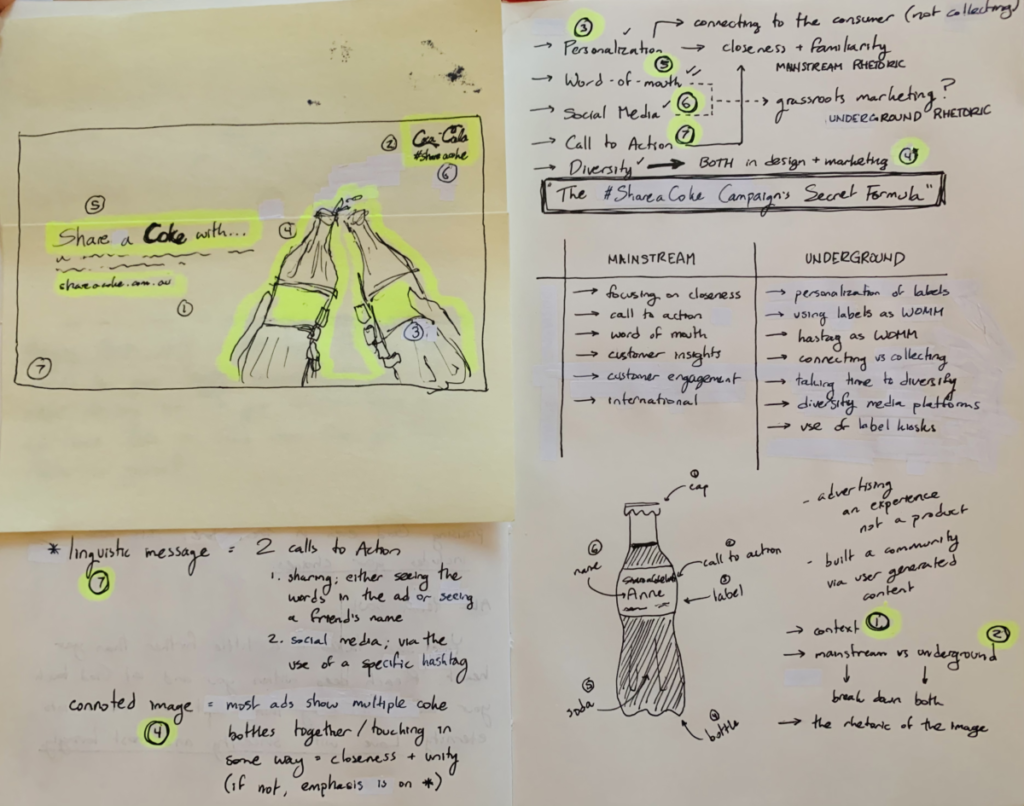Tag: shareacoke

Barnhart, Brent. “How to Make Sure You’re Marketing to Gen Z the Right Way.” Sprout Social, 11 Nov. 2019, sproutsocial.com/insights/marketing-to-gen-z/.
Codella, Daniel. “The Winning Coca-Cola Formula for a Successful Campaign.” Wrike, Wrike, 6 Apr. 2018, www.wrike.com/blog/winning-coca-cola-formula-successful-campaign/.
Crawford, Elizabeth Crisp, and Jeremy Jackson. “Philanthropy in the Millennial Age: Trends toward Polycentric Personalized Philanthropy.” Independent Review, vol. 23, no. 4, 2019, p. 551+. Gale Academic OneFile, https://link.gale.com/apps/doc/A581175535/AONE?u=cuny_nytc&sid=AONE&xid=0dea4ab3. Accessed 23 Nov. 2020.
Heller, Steven. “The Underground Mainstream.” Graphic Design Theory: Readings from the Field, by Helen Armstrong, Princeton Architectural Press, 2012, pp. 98–101.
Henderson, Geraldine Rosa, and Jerome D. Williams. “From Exclusion to Inclusion: An Introduction to the Special Issue on Marketplace Diversity and Inclusion.” Journal of Public Policy & Marketing, vol. 32, 2013, pp. 1–5. JSTOR, www.jstor.org/stable/43305308. Accessed 23 Nov. 2020.
“How a Campaign Got Its Start Down Under – News & Articles.” The Coca-Cola Company: Refresh the World. Make a Difference, The Coca-Cola Company, 25 Sept. 2014, www.coca-colacompany.com/news/how-a-campaign-got-its-start-down-under.
Kozinets, Robert V., et al. “Networked Narratives: Understanding Word-of-Mouth Marketing in Online Communities.” Journal of Marketing, vol. 74, no. 2, 2010, pp. 71–89. JSTOR, www.jstor.org/stable/20619091. Accessed 23 Nov. 2020.
Kumar, V. “Evolution of Marketing as a Discipline: What Has Happened and What to Look Out For.” Journal of Marketing, vol. 79, no. 1, 2015, pp. 1–9. JSTOR, www.jstor.org/stable/43784378. Accessed 28 Nov. 2020.
Liu, Yizao, and Rigoberto A. Lopez. “The Impact of Social Media Conversations on Consumer Brand Choices.” Marketing Letters, vol. 27, no. 1, 2016, pp. 1–13. JSTOR, www.jstor.org/stable/26177931. Accessed 29 Nov. 2020.
O’Connor, Padraig. “What To Know When Marketing To Millennials.” Social Media Week, 28 July 2015, socialmediaweek.org/blog/2015/07/marketing-to-millennials/.
Sonesson, Göran. “Rhetoric of the Image.” Encyclopedia of Semiotics. : Oxford University Press, , 2007. Oxford Reference. Date Accessed 28 Nov. 2020 <https://www.oxfordreference.com/view/10.1093/acref/9780195120905.001.0001/acref-9780195120905-e-248>.
Tarver, Evan. “Why the ‘Share a Coke’ Campaign Is So Successful.” Investopedia, Investopedia, 28 Aug. 2020, www.investopedia.com/articles/markets/100715/what-makes-share-coke-campaign-so-successful.asp.
Whitler, Kimberly A. “Why Word Of Mouth Marketing Is The Most Important Social Media.” Forbes, Forbes Magazine, 9 Sept. 2019, www.forbes.com/sites/kimberlywhitler/2014/07/17/why-word-of-mouth-marketing-is-the-most-important-social-media/?sh=4b98dc9e54a8.
Underground creators are always intentionally or unintentionally testing the ground for new things and many times those new things are met with some rejection. However, once that “thing” receives enough acceptance it becomes a demographic to target and the mainstream takes advantage of it. Mainstream puts a label or gives the once underground design some spotlight, bringing it to widespread acceptance. Once that happens, the “thing” is no longer “underground”. Mainstream design is also influenced by the fact that once an underground thing becomes mainstream, the overall tolerance and definition of what is “mainstream” changes. If the underground creator’s intention was to change the game, to influence the culture of the mainstream, then the underground creator achieves their goal. If that was not the creators goal, the rules of the game in the mainstream still change.
I believe that my design (#ShareaCoke) and designer (The Coca-Cola Company) fir into this dichotomy not from from the design perspective of advertising, but rather the marketing perspective of advertising. At the time of its release, Coca-Cola understood that they were in fact too mainstream. They were too familiar and a big corporate brand. Millennials and younger were their target market, which was and is a demographic well known for not trusting in corporations. The “underground” in this scenario lies in three factors: personalization, word-of-mouth, and social media.
Word-of-mouth (WOM) was well established as a powerful and influential marketing technique. However, up until the early 2010s it had been seen through the lens of “a marketing world untouched by the Internet. …accessibility, reach and transparency have empowered marketers … like never before.” Coca-Cola tapped into the power of the digital world rather reluctantly, as it was still an unknown factor at the time of the campaign’s release, but its success in building international was heavily reliant on internet and social media platforms. Combine WOM influence with social media influence and you have quite a bit of reach. The final ingredient is the personalization of the ad – adding the names – that allowed Coca-Cola to begin “…speaking to our fans at eye level.”
The personalization of the #ShareaCoke took into account the almost “avant-garde” mentality that was the millennial generation. This mentality of brand promotion being primarily “peer produced” is what one could consider “underground”. It wasn’t a mainstream thing to connect on that level with the consumer. Unknowingly, Coca-Cola was able to exponentially increase its reach by combining that underground mentality with an underground method of marketing as people started to run with this “personalized” ad and flood social media with the WOM buzz. If one considers that Instagram was launched in October of 2010, and the #ShareaCoke campaign started in Australia in 2011, then I believe it is safe to say that Coke-Cola radically changed the advertisement and marketing industry, its relationship with social media influence, and discovered the power of the new millennial mindset, thus changing the mainstream marketing game forever.
—
Crawford, Elizabeth Crisp, and Jeremy Jackson. “Philanthropy in the Millennial Age: Trends toward Polycentric Personalized Philanthropy.” Independent Review, vol. 23, no. 4, 2019, p. 551+. Gale Academic OneFile, https://link.gale.com/apps/doc/A581175535/AONE?u=cuny_nytc&sid=AONE&xid=0dea4ab3. Accessed 23 Nov. 2020.
“How a Campaign Got Its Start Down Under – News & Articles.” The Coca-Cola Company: Refresh the World. Make a Difference, The Coca-Cola Company, 25 Sept. 2014, www.coca-colacompany.com/news/how-a-campaign-got-its-start-down-under.
Kozinets, Robert V., et al. “Networked Narratives: Understanding Word-of-Mouth Marketing in Online Communities.” Journal of Marketing, vol. 74, no. 2, 2010, pp. 71–89. JSTOR, www.jstor.org/stable/20619091. Accessed 23 Nov. 2020.



Recent Comments